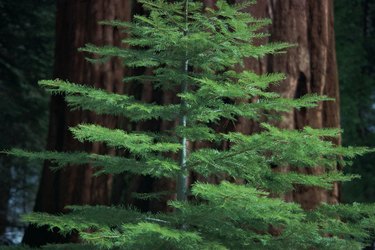
A redwood tree evokes images of massively trunked and towering trees in the parks of northern California. There are three species of trees commonly called redwood trees, and each attains a different size and tolerates different climatic conditions. The American Northeast's winters pose the most limiting factor to growing the various redwood trees.
Winter Conditions
Video of the Day
The Northeast is generally described as the states north and east of Pennsylvania and New Jersey. However, some people consider Pennsylvania and New Jersey part of the Mid-Atlantic region and consider the Northeast as New York and all states in New England. Winters in this part of the country, no matter which states are included, are cold with winds and snow. Average low minimum temperatures range from zero to minus 40 degrees Fahrenheit. This correlated to U.S. Department of Agriculture plant hardiness zones 4 through 7a. The mildest winters are in the southern areas near the Atlantic Ocean.
Video of the Day
Coastal Redwood
The California or coastal redwood (Sequoia sempervirens) is the behemoth tree of renown. In its native coastal ranges of California and southwestern Oregon, it can reach over 300 feet tall and 30 to 50 feet wide. Coastal redwood does not reliably survive winters that are colder than 0 degrees Fahrenheit. It is suitable only for the southernmost parts of the Northeast. A coastal redwood tree grows at Longwood Gardens in Kennett Square Pennsylvania, to the west of Philadelphia. The Brooklyn Botanic Garden in New York City also has coastal redwoods in its living collection. There are also container-grown bonsai specimens.
Giant Sequoia
Also called big tree or Sierra redwood, the giant sequoia (Sequoiadendron giganteum) demonstrates greater winter hardiness compared to the coastal redwood. In the Northeast, expect it to grow 60 to 100 feet tall, far shorter than the common height of 200 feet found in specimens from the Sierra Nevada Mountains. Giant sequoia is suitable to grow in USDA zone 5b through 7, which includes roughly the southeastern third of the Northeast. Speciments grow at the Tyler Arboretum and Longwood Gardens in Pennsylvania, Brooklyn Botanic Garden, the Arnold Arboretum in Boston, Massachusetts, and Cornell Plantations -- the arboretum and botanical garden of Cornell University -- in Ithaca, New York.
Dawn Redwood
The dawn redwood (Metasequoia glyptostroboides) is the most widely adaptable redwood tree across the Northeast. Grow it in the southern half of the region where winters aren't colder than minus 15 degrees Fahrenheit, or in USDA zones 5 and warmer. Maturing 70 to 100 feet tall, a dawn redwood displays orange foliage before the needles drop off in autumn. Dawn redwood trees grow at Longwood Gardens, Brooklyn Botanic Garden, the Arnold Arboretum, Cornell Plantations and the Coastal Maine Botanical Gardens in Boothbay.
- Brooklyn Botanic Garden: Plant Records Database
- Longwood Gardens: Plant Explorer Database
- Cornell Plantations: Find a Plant or Memorial Database
- National Gardening Association: USDA Hardiness Zone Finder
- Learn2Grow: Sequoia Sempervirens
- Learn2Grow: Sequoiadendron Giganteum
- Learn2Grow: Metasequoia Glyptostobioides